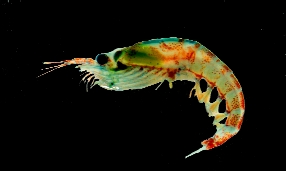 |
The CCAMLR krill synoptic survey |
 |
The CCAMLR krill synoptic survey |
• Upon retrieval of the gear ensure that all zooplankton adhering to the net is washed down with seawater into the cod end liner.
• Once cod end liner has been brought into laboratory gently invert the cod-end liner over a tray or bucket and wash out the contents. Concentrate the catch by filtration through a sieve of mesh size smaller than the net mesh (ie <330 ?m).
• A measure of displacement volume for the whole catch is required. This can be achieved by placing the drained catch contents in a known volume of sea-water and noting the increase equivalent to the displacement volume of the catch.
• Place catch or appropriate sub-sample into a jar and preserve with 10% (v:v) formaldehyde solution. Ensure that enough preservative is used to fix the catch. As a guide we have found that a ratio of 3-4:1, preservative:catch, is generally adequate to ensure the good condition of most taxa in the sample, at least in the short-term. Do not use less preservative than this.
• Make out a record of the following station and catch details in pencil on a waterproof paper label:Date, Start Time, End Time (GMT),Place label IN the sample jar and store safely.
Position (Lat Long)
Station, Transect Number (Event Number), Sample Volume
Fraction preserved if subsample
Flow reading (Volume swept.)
We know that the RMT1+8 presents a variable mouth area dependent on speed through the water (Pommeranz et al. 1982). Accordingly a log should be kept of wire-out against time and also of distance travelled by the ship.
Notwithstanding decisions as to whether samples are sorted onboard ship or back in the home laboratory we need to ensure that the same degree of taxonomic rigour is applied to the samples by all participating nations. We can generate a sample sorting list of those species that we expect to encounter but if identification problems are experienced then examples of those representative taxa should be set aside for general examination/opinion of other workers. Even if samples are sorted onboard ship then it is still vitally important that the samples (or representative subsamples) are preserved for later examination.
| Introduction | Itinerary | Station positions | Cruise tracks | Planning Meeting | Sampling Protocols | Participants | Background papers | Contents |
Page last updated on 17 November 1999